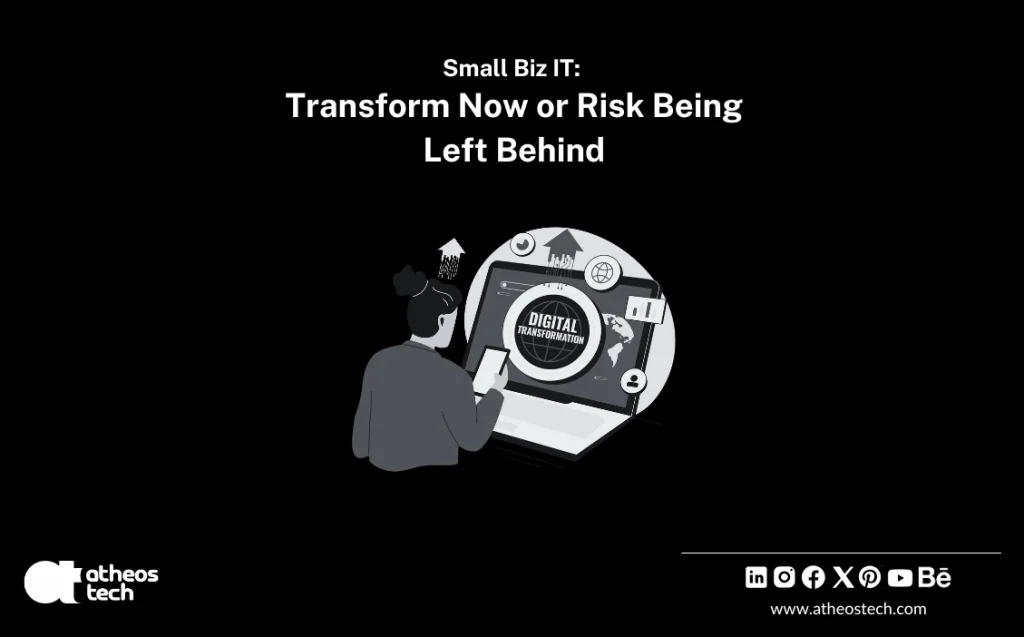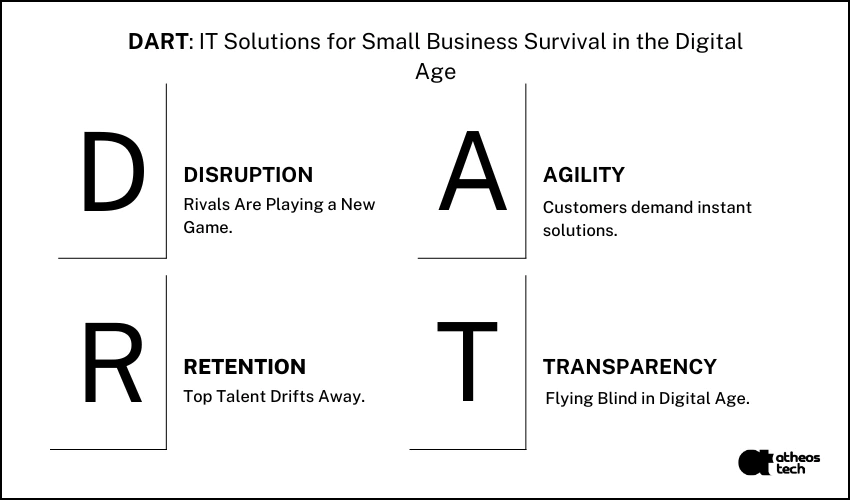
Hire UI UX Designer to Transform Your Brand Across Every Digital Channel

[Scene: A Zoom call. Monday morning. A mid-market business owner from London, let’s call him Richard, is speaking with a consultant from AtheosTech, a small business consulting company. The consultant’s calm. Richard’s proud… for now.]
Richard:
“We’ve already done the digital transformation bit, mate. We’re using Slack, migrated to Google Workspace, and even automated payroll – essentially all the small business IT solutions one can think of”
AtheosTech Consultant:
“That’s great, Richard. So tell me – when your sales team misses a quota, what does your tech stack tell you within 24 hours?”
Richard:
“Uh… I mean, we review reports weekly. Sometimes bi-weekly. Depends.”
AtheosTech Consultant:
“Got it. And if I asked your operations lead to spin up a new customer onboarding flow today – how long would it take without pinging IT?”
Richard:
“Well… probably need to sync with our dev guy. He’s freelance, though. Based in Poland.”
AtheosTech Consultant:
“One more: What’s your cost-to-convert per channel – email vs paid vs organic – and which one is most scalable?”
Richard:
(pauses)
“That’s… with the agency. I think.”
Consultant (smiling, politely brutal):
“Richard, I’m going to be blunt. What you’ve done isn’t digital transformation. It’s a digital decoration. You need a real small business consultant, not a cousin who ‘knows WordPress.’”
This is where most SMBs are.
They’ve bought the tech.
They’ve got the tools.
But they’re still reacting, not predicting.
They’re still managing, not scaling.
And most of all – they’re digitally busy, but not digitally mature.
The worst part?
They think they’re done.
This isn’t just a Richard problem. It’s happening in Toronto, Singapore, Berlin, Sydney, Dubai, and every second corner office that uses the words “we’re digital now” as a post-it note over operational chaos.
In this guide, we’ll strip the buzzwords and show you the truth.
Ready to take the ego hit and see where you actually stand?
Let’s begin.
Let’s not waste time. Let’s slay the dragon in the room. Before we talk about what digital transformation is, let’s clear the fog and talk about what it absolutely isn’t – even though too many SMBs think it is.
Because until you unlearn the noise, you won’t hear the signal.
If any of the below sounds familiar, don’t panic. You’re in good company.
Just don’t confuse tech upgrades with business transformation – they’re not the same sport.
| Scenario | Reality |
|---|---|
| "We moved everything to the cloud" | Nice. Now you can lose files digitally instead of in filing cabinets. Digitization ≠ transformation. |
| "We installed a CRM" | If your team updates it once a week under duress, you’ve added friction, not capability. Owning tech isn’t the same as integrating it into decision-making. |
| "We automated payroll and invoices" | That’s housekeeping. Not strategy. You’ve saved some time. You haven’t changed how your business operates. |
| "We hired an IT team" | They’re critical, but unless they’re driving innovation, they’re just maintaining your digital status quo. Is your tech guy really a small business consultant? Support ≠ scale. |
| "We launched an app" | Cool. Does it solve a real problem or just give you something to post on LinkedIn? Digital gimmicks are not transformation milestones. |
| "We use Slack, Zoom, and some AI tools" | So does everyone else. Don’t confuse scattered apps and software patches as complete small business IT solutions - they’re digital stickers on structural inefficiencies. |
If your business:
Then no – you haven’t transformed.
You’ve just digitized dysfunction.
If it’s not any of the above, what is it? After all the myths are stripped away, the definition is simple and powerful. Technically speaking…
“
Digital transformation is the strategic integration of digital technologies across all functional areas of a business, resulting in fundamental changes to its operations, value delivery mechanisms, and stakeholder experiences.
It involves reengineering business processes, leveraging data-driven decision-making, enabling organizational agility, and aligning technology investments with long-term strategic objectives.
In short:
It’s not just about using tech – it’s about redesigning your business model to perform better in a digital-first economy. It’s about partnering with a small business consultant who understands your operational DNA.
”
Now, let’s translate that from consultant-speak into plain English. Practically speaking…
“
Digital Transformation is building a digital nervous system – the kind of integrated small business IT solution that scales with you. It’s the point where your technology, your team, and your processes stop being separate, warring factions and start working as one intelligent unit. It’s about eliminating the stupid, repetitive tasks your smart employees hate doing so they can focus on work that actually requires a brain.
It’s the difference between running your business by memory and instinct, versus running it on a live, data-driven dashboard.
Digital transformation is when your business stops reacting to problems – and starts running itself smarter, faster, and leaner; using technology that’s deeply woven into your day-to-day decisions and growth engine.
It’s the point where:
”
Let’s shout out, and embrace the truth here.
For an SMB, digital transformation isn’t about “getting an app” or “going paperless.” It’s not about having a fancy-looking dashboard or signing up for 17 SaaS tools you’ll never fully use.
It’s about this fundamental operational shift:
| Old State | New State |
|---|---|
| Manual: Things get done only when someone remembers to do them | Automated: Repetitive processes trigger themselves |
| Fragmented: Info lives in 8 tools, 4 Excel sheets, and someone's head | Integrated: Everything talks to everything |
| Reactive: You respond to problems after they occur | Proactive: You see them coming and steer around them |

Here’s why this isn’t something you can just add to a to-do list anymore.
Stop decorating. Start transforming.
Right now, there’s a thought running through your head. It’s a comforting one.
“My industry is different. We’re built on relationships.”
“My business is based on a specific craft.”
“This tech stuff doesn’t really apply to my sector.”
That’s a lovely sentiment. It’s also a dangerous delusion. Don’t believe me? Let’s stop talking in hypotheticals and look at the hard numbers. This isn’t a forecast. This is a report from a race already in progress. While small business consulting firms are pushing clients toward smarter infrastructure, most SMBs are still running their ops from spreadsheets.
Here’s a snapshot of digital adoption across various sectors:
Speaking region-wise:
Whereas:
Why These Numbers Matter to You
We’ve covered a lot of ground. And if you’re still with me, congratulations. It means you’re one of the few who are willing to look in the mirror, even if you don’t like the reflection.
We started with Richard, the proud business owner who thought he had achieved digital transformation, only to have an AtheosTech consultant show him he had only achieved digital decoration.
We tore down the buzzwords and established a simple, brutal definition of digital transformation: moving your business from being Manual, Fragmented, and Reactive to Automated, Integrated, and Proactive.
We looked at the scoreboard and saw, in stark numbers, that your industry isn’t a special exception. It’s a racetrack, and the race has already begun.
So now what?
You can close this tab. You can go back to your overflowing inbox and your “master” spreadsheet. You can tell yourself that this is a problem for next quarter, for the person you’ll hire next year, for a future that never quite arrives. You can keep rowing your boat, perfecting your stroke, while the speedboats of your competitors disappear over the horizon.
Or you can make a different choice.
Digital transformation isn’t a project you can delegate. It’s a leadership decision that only you can make. It’s the moment you stop coping and start building.
Your competitors aren’t waiting
Why should you?
Don’t let this be another article you read and forgot. The gap between insight and action is where businesses fail. Here are your orders.
The choice to adapt small business IT solutions or fall behind isn’t a future event. It’s a decision you make every day, in every inefficient process you choose to tolerate. It’s THE decision you make NOW.
Talk to AtheosTech – the consultation-first team offering consulting services for small business that are done playing small.
Adding {{itemName}} to cart
Added {{itemName}} to cart